Bank1 Enterprise Architecture: Implementing Design and Process Map
VerifiedAdded on 2022/10/12
|12
|2343
|195
Report
AI Summary
This report analyzes the enterprise architecture of Bank1, focusing on the design and implementation phases, along with the development of a process map. The report begins with an introduction to the case study, providing background information on Bank1, including its global operations, employee count, and strategic shifts. The design phase explores the bank's structure, including its employees, countries, and customers, and highlights the need for radical change in its business model. The report defines the architects' roles and perspectives, emphasizing their focus on enabling strategy and selecting appropriate hardware and software. The implementation phase delves into the concept of enterprise architecture, discussing its role in analysis, design, and planning, and outlining requirements such as cost-benefit analysis and management security controls. The report also covers products and programs related to enterprise architecture, along with process mapping techniques used for detailed analysis. The report provides a comprehensive overview of Bank1's enterprise architecture, its components, and the operational processes involved.
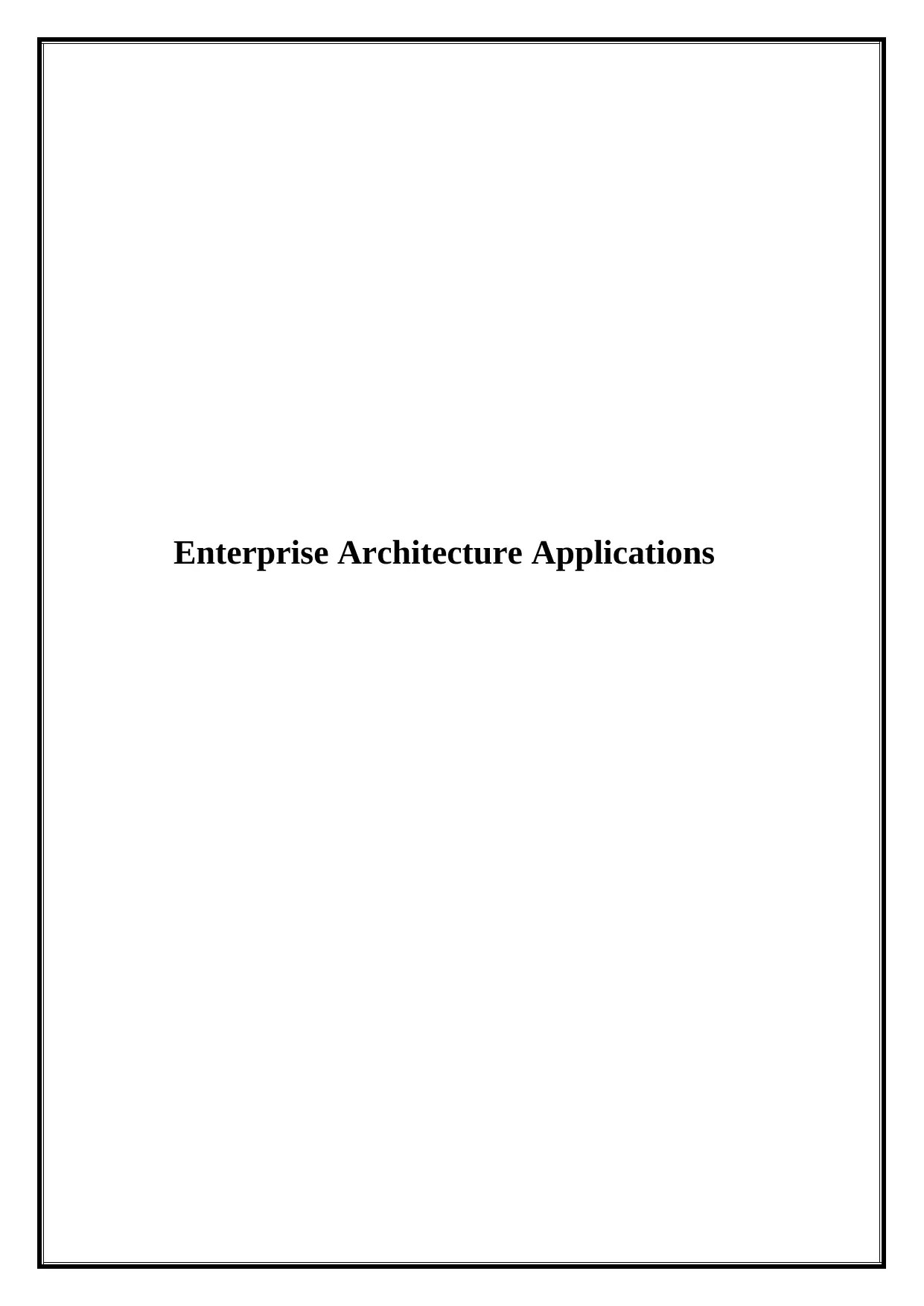
Enterprise Architecture Applications
Paraphrase This Document
Need a fresh take? Get an instant paraphrase of this document with our AI Paraphraser
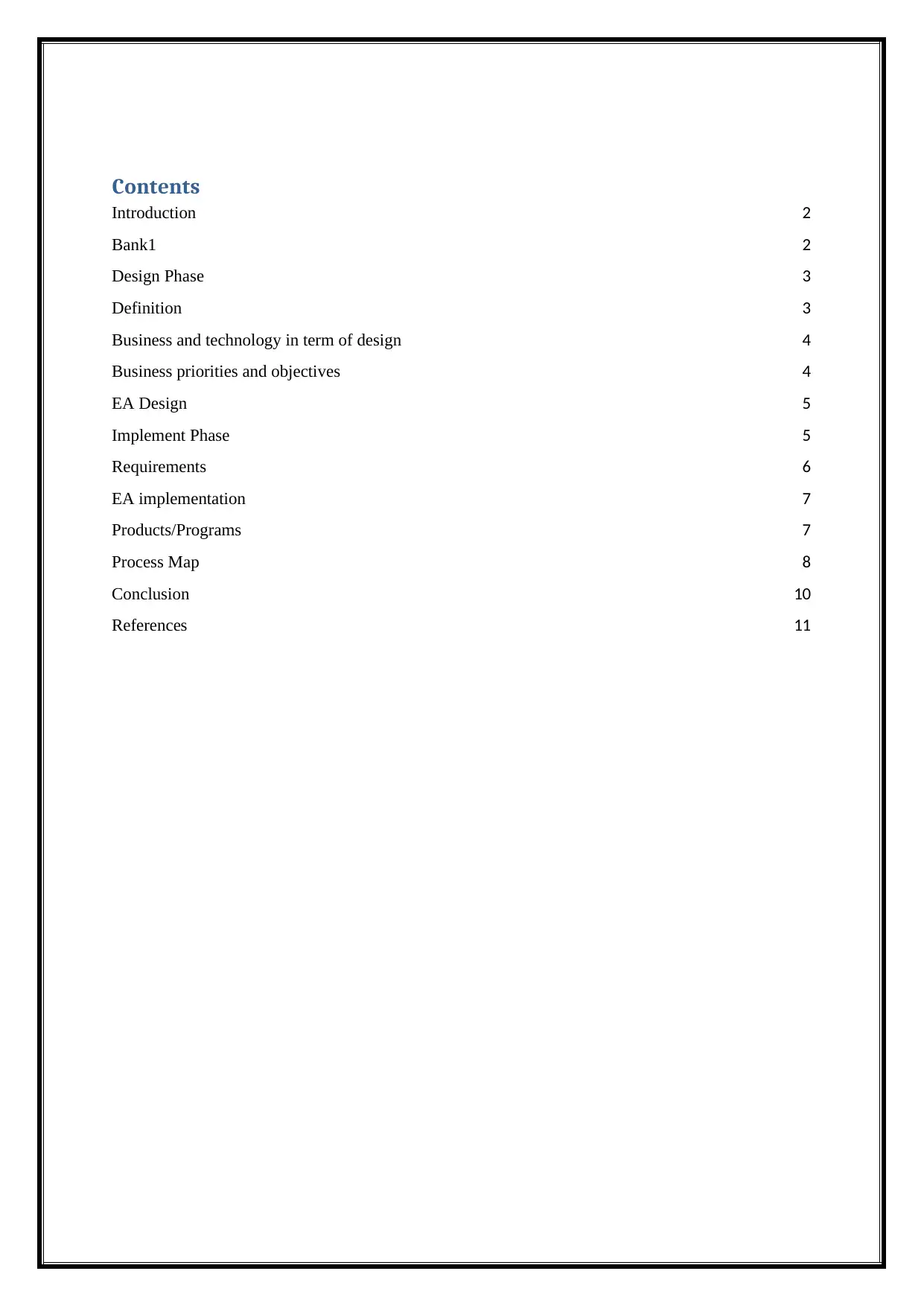
Contents
Introduction 2
Bank1 2
Design Phase 3
Definition 3
Business and technology in term of design 4
Business priorities and objectives 4
EA Design 5
Implement Phase 5
Requirements 6
EA implementation 7
Products/Programs 7
Process Map 8
Conclusion 10
References 11
Introduction 2
Bank1 2
Design Phase 3
Definition 3
Business and technology in term of design 4
Business priorities and objectives 4
EA Design 5
Implement Phase 5
Requirements 6
EA implementation 7
Products/Programs 7
Process Map 8
Conclusion 10
References 11
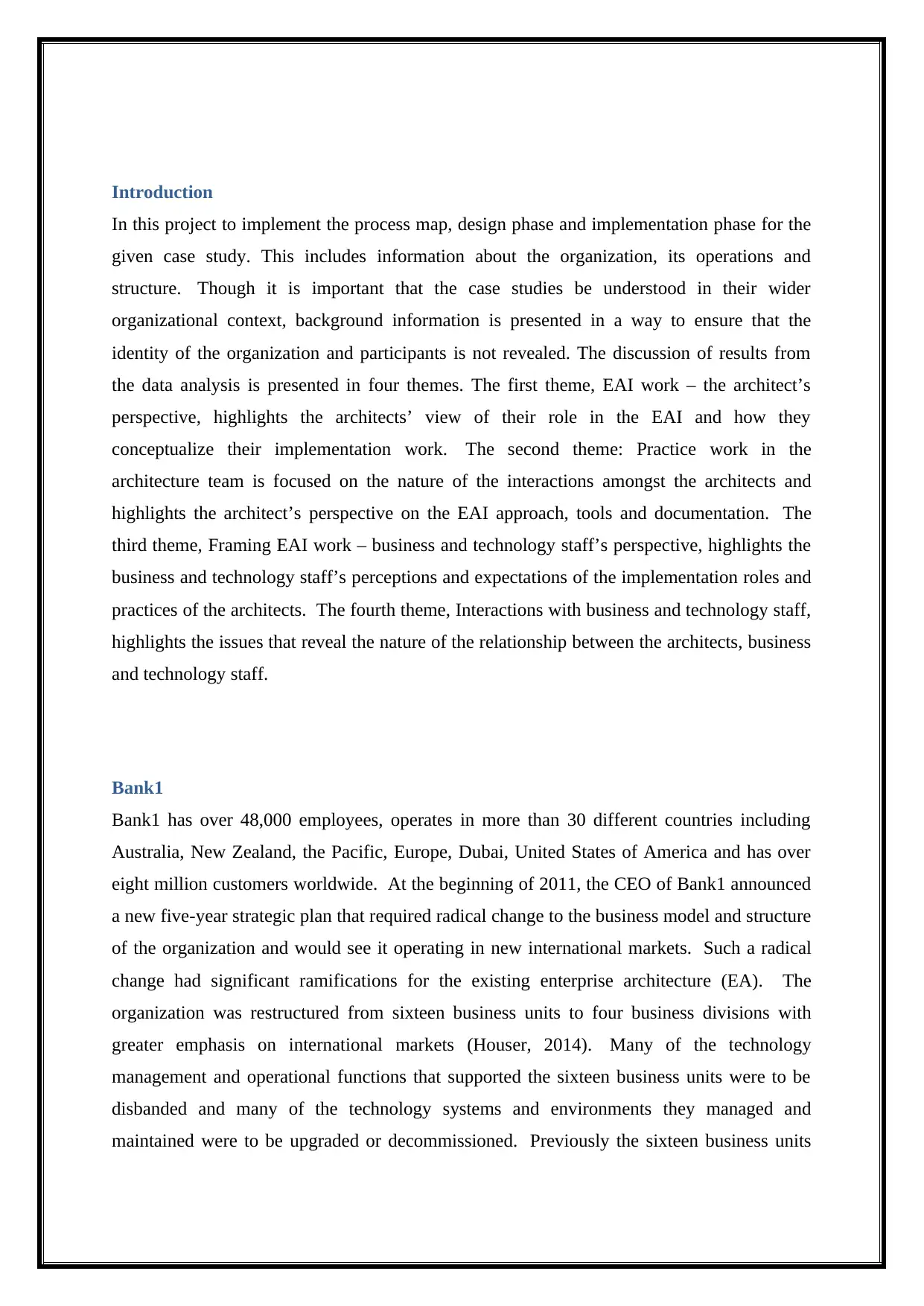
Introduction
In this project to implement the process map, design phase and implementation phase for the
given case study. This includes information about the organization, its operations and
structure. Though it is important that the case studies be understood in their wider
organizational context, background information is presented in a way to ensure that the
identity of the organization and participants is not revealed. The discussion of results from
the data analysis is presented in four themes. The first theme, EAI work – the architect’s
perspective, highlights the architects’ view of their role in the EAI and how they
conceptualize their implementation work. The second theme: Practice work in the
architecture team is focused on the nature of the interactions amongst the architects and
highlights the architect’s perspective on the EAI approach, tools and documentation. The
third theme, Framing EAI work – business and technology staff’s perspective, highlights the
business and technology staff’s perceptions and expectations of the implementation roles and
practices of the architects. The fourth theme, Interactions with business and technology staff,
highlights the issues that reveal the nature of the relationship between the architects, business
and technology staff.
Bank1
Bank1 has over 48,000 employees, operates in more than 30 different countries including
Australia, New Zealand, the Pacific, Europe, Dubai, United States of America and has over
eight million customers worldwide. At the beginning of 2011, the CEO of Bank1 announced
a new five-year strategic plan that required radical change to the business model and structure
of the organization and would see it operating in new international markets. Such a radical
change had significant ramifications for the existing enterprise architecture (EA). The
organization was restructured from sixteen business units to four business divisions with
greater emphasis on international markets (Houser, 2014). Many of the technology
management and operational functions that supported the sixteen business units were to be
disbanded and many of the technology systems and environments they managed and
maintained were to be upgraded or decommissioned. Previously the sixteen business units
In this project to implement the process map, design phase and implementation phase for the
given case study. This includes information about the organization, its operations and
structure. Though it is important that the case studies be understood in their wider
organizational context, background information is presented in a way to ensure that the
identity of the organization and participants is not revealed. The discussion of results from
the data analysis is presented in four themes. The first theme, EAI work – the architect’s
perspective, highlights the architects’ view of their role in the EAI and how they
conceptualize their implementation work. The second theme: Practice work in the
architecture team is focused on the nature of the interactions amongst the architects and
highlights the architect’s perspective on the EAI approach, tools and documentation. The
third theme, Framing EAI work – business and technology staff’s perspective, highlights the
business and technology staff’s perceptions and expectations of the implementation roles and
practices of the architects. The fourth theme, Interactions with business and technology staff,
highlights the issues that reveal the nature of the relationship between the architects, business
and technology staff.
Bank1
Bank1 has over 48,000 employees, operates in more than 30 different countries including
Australia, New Zealand, the Pacific, Europe, Dubai, United States of America and has over
eight million customers worldwide. At the beginning of 2011, the CEO of Bank1 announced
a new five-year strategic plan that required radical change to the business model and structure
of the organization and would see it operating in new international markets. Such a radical
change had significant ramifications for the existing enterprise architecture (EA). The
organization was restructured from sixteen business units to four business divisions with
greater emphasis on international markets (Houser, 2014). Many of the technology
management and operational functions that supported the sixteen business units were to be
disbanded and many of the technology systems and environments they managed and
maintained were to be upgraded or decommissioned. Previously the sixteen business units
⊘ This is a preview!⊘
Do you want full access?
Subscribe today to unlock all pages.

Trusted by 1+ million students worldwide
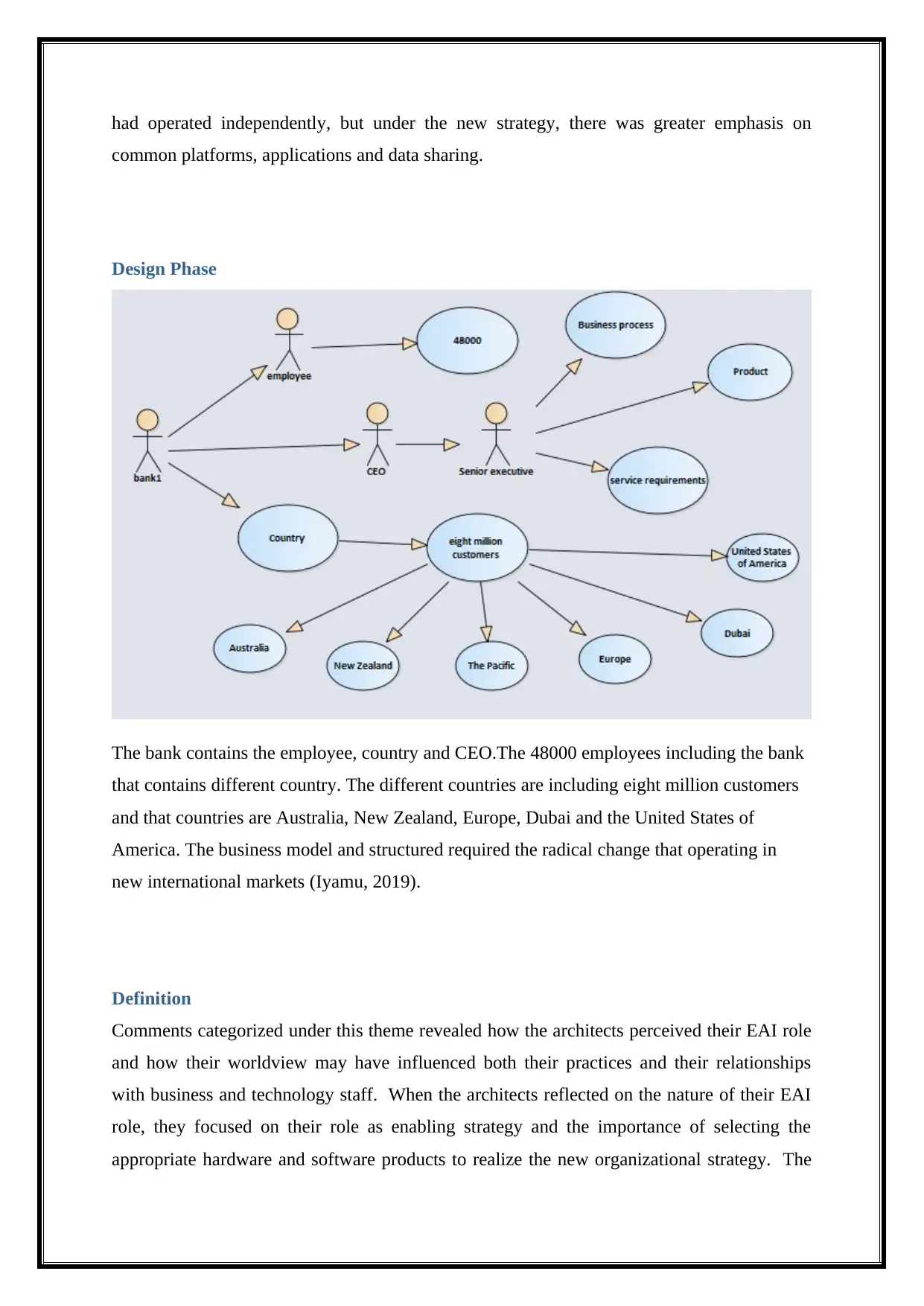
had operated independently, but under the new strategy, there was greater emphasis on
common platforms, applications and data sharing.
Design Phase
The bank contains the employee, country and CEO.The 48000 employees including the bank
that contains different country. The different countries are including eight million customers
and that countries are Australia, New Zealand, Europe, Dubai and the United States of
America. The business model and structured required the radical change that operating in
new international markets (Iyamu, 2019).
Definition
Comments categorized under this theme revealed how the architects perceived their EAI role
and how their worldview may have influenced both their practices and their relationships
with business and technology staff. When the architects reflected on the nature of their EAI
role, they focused on their role as enabling strategy and the importance of selecting the
appropriate hardware and software products to realize the new organizational strategy. The
common platforms, applications and data sharing.
Design Phase
The bank contains the employee, country and CEO.The 48000 employees including the bank
that contains different country. The different countries are including eight million customers
and that countries are Australia, New Zealand, Europe, Dubai and the United States of
America. The business model and structured required the radical change that operating in
new international markets (Iyamu, 2019).
Definition
Comments categorized under this theme revealed how the architects perceived their EAI role
and how their worldview may have influenced both their practices and their relationships
with business and technology staff. When the architects reflected on the nature of their EAI
role, they focused on their role as enabling strategy and the importance of selecting the
appropriate hardware and software products to realize the new organizational strategy. The
Paraphrase This Document
Need a fresh take? Get an instant paraphrase of this document with our AI Paraphraser
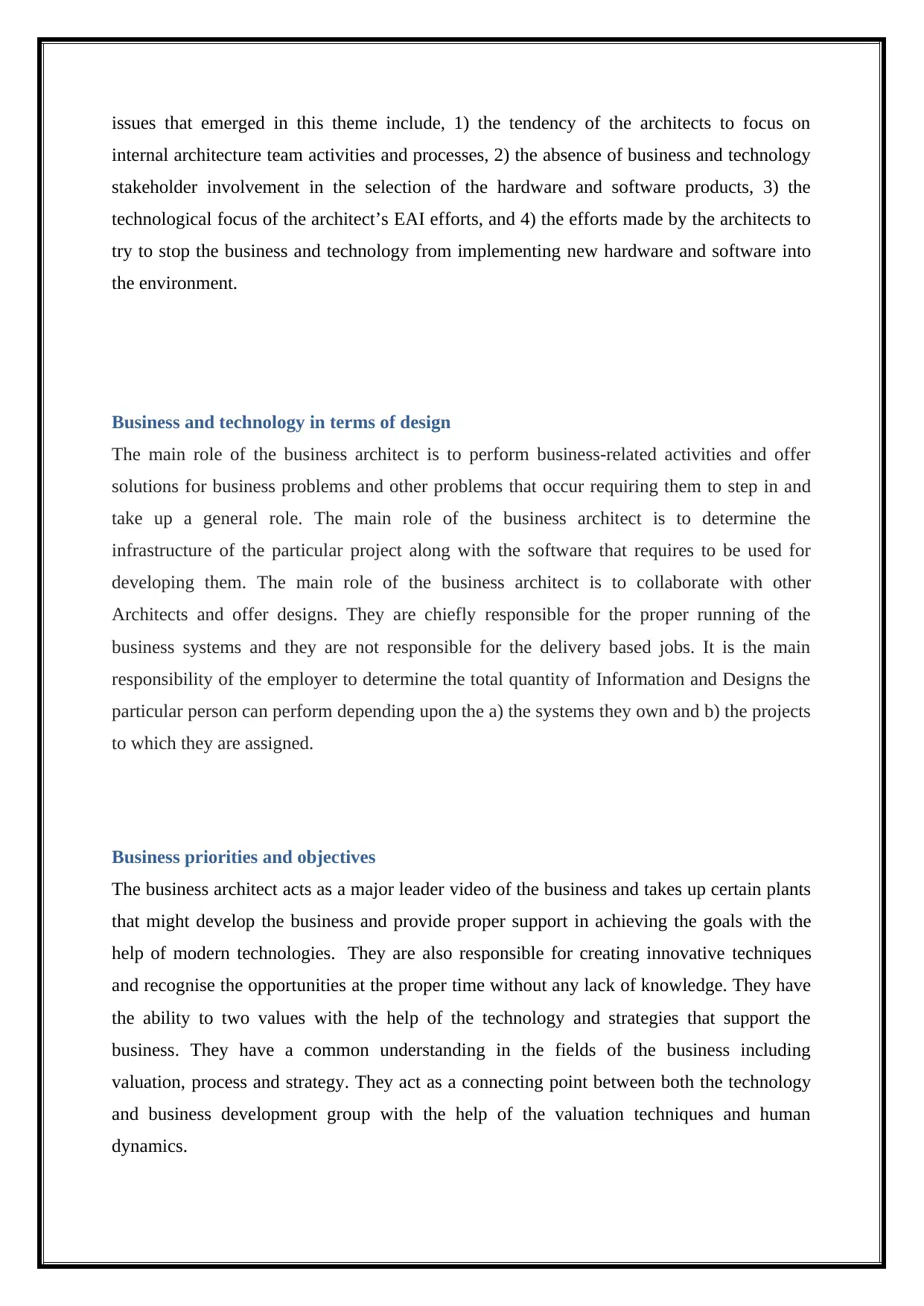
issues that emerged in this theme include, 1) the tendency of the architects to focus on
internal architecture team activities and processes, 2) the absence of business and technology
stakeholder involvement in the selection of the hardware and software products, 3) the
technological focus of the architect’s EAI efforts, and 4) the efforts made by the architects to
try to stop the business and technology from implementing new hardware and software into
the environment.
Business and technology in terms of design
The main role of the business architect is to perform business-related activities and offer
solutions for business problems and other problems that occur requiring them to step in and
take up a general role. The main role of the business architect is to determine the
infrastructure of the particular project along with the software that requires to be used for
developing them. The main role of the business architect is to collaborate with other
Architects and offer designs. They are chiefly responsible for the proper running of the
business systems and they are not responsible for the delivery based jobs. It is the main
responsibility of the employer to determine the total quantity of Information and Designs the
particular person can perform depending upon the a) the systems they own and b) the projects
to which they are assigned.
Business priorities and objectives
The business architect acts as a major leader video of the business and takes up certain plants
that might develop the business and provide proper support in achieving the goals with the
help of modern technologies. They are also responsible for creating innovative techniques
and recognise the opportunities at the proper time without any lack of knowledge. They have
the ability to two values with the help of the technology and strategies that support the
business. They have a common understanding in the fields of the business including
valuation, process and strategy. They act as a connecting point between both the technology
and business development group with the help of the valuation techniques and human
dynamics.
internal architecture team activities and processes, 2) the absence of business and technology
stakeholder involvement in the selection of the hardware and software products, 3) the
technological focus of the architect’s EAI efforts, and 4) the efforts made by the architects to
try to stop the business and technology from implementing new hardware and software into
the environment.
Business and technology in terms of design
The main role of the business architect is to perform business-related activities and offer
solutions for business problems and other problems that occur requiring them to step in and
take up a general role. The main role of the business architect is to determine the
infrastructure of the particular project along with the software that requires to be used for
developing them. The main role of the business architect is to collaborate with other
Architects and offer designs. They are chiefly responsible for the proper running of the
business systems and they are not responsible for the delivery based jobs. It is the main
responsibility of the employer to determine the total quantity of Information and Designs the
particular person can perform depending upon the a) the systems they own and b) the projects
to which they are assigned.
Business priorities and objectives
The business architect acts as a major leader video of the business and takes up certain plants
that might develop the business and provide proper support in achieving the goals with the
help of modern technologies. They are also responsible for creating innovative techniques
and recognise the opportunities at the proper time without any lack of knowledge. They have
the ability to two values with the help of the technology and strategies that support the
business. They have a common understanding in the fields of the business including
valuation, process and strategy. They act as a connecting point between both the technology
and business development group with the help of the valuation techniques and human
dynamics.
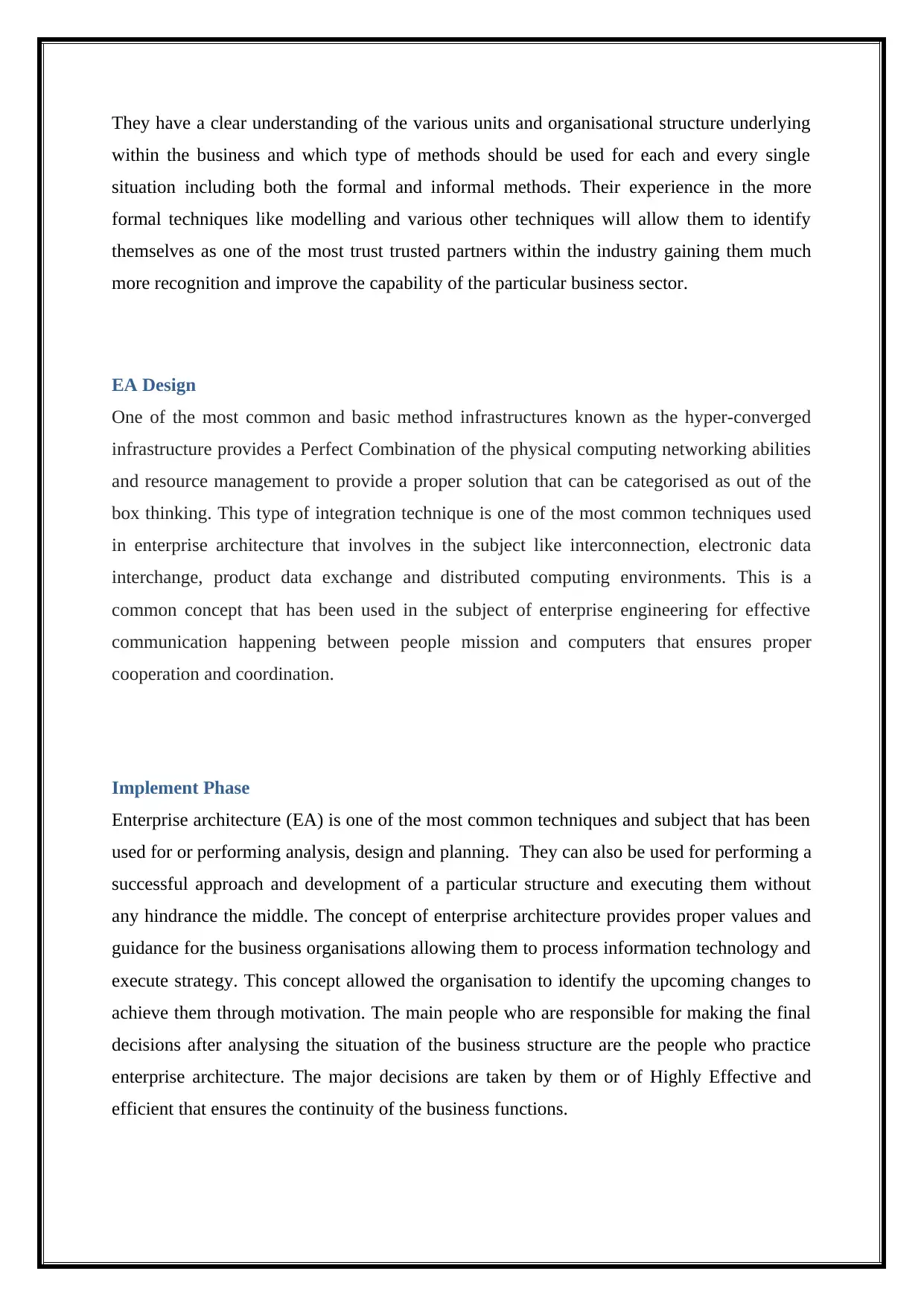
They have a clear understanding of the various units and organisational structure underlying
within the business and which type of methods should be used for each and every single
situation including both the formal and informal methods. Their experience in the more
formal techniques like modelling and various other techniques will allow them to identify
themselves as one of the most trust trusted partners within the industry gaining them much
more recognition and improve the capability of the particular business sector.
EA Design
One of the most common and basic method infrastructures known as the hyper-converged
infrastructure provides a Perfect Combination of the physical computing networking abilities
and resource management to provide a proper solution that can be categorised as out of the
box thinking. This type of integration technique is one of the most common techniques used
in enterprise architecture that involves in the subject like interconnection, electronic data
interchange, product data exchange and distributed computing environments. This is a
common concept that has been used in the subject of enterprise engineering for effective
communication happening between people mission and computers that ensures proper
cooperation and coordination.
Implement Phase
Enterprise architecture (EA) is one of the most common techniques and subject that has been
used for or performing analysis, design and planning. They can also be used for performing a
successful approach and development of a particular structure and executing them without
any hindrance the middle. The concept of enterprise architecture provides proper values and
guidance for the business organisations allowing them to process information technology and
execute strategy. This concept allowed the organisation to identify the upcoming changes to
achieve them through motivation. The main people who are responsible for making the final
decisions after analysing the situation of the business structure are the people who practice
enterprise architecture. The major decisions are taken by them or of Highly Effective and
efficient that ensures the continuity of the business functions.
within the business and which type of methods should be used for each and every single
situation including both the formal and informal methods. Their experience in the more
formal techniques like modelling and various other techniques will allow them to identify
themselves as one of the most trust trusted partners within the industry gaining them much
more recognition and improve the capability of the particular business sector.
EA Design
One of the most common and basic method infrastructures known as the hyper-converged
infrastructure provides a Perfect Combination of the physical computing networking abilities
and resource management to provide a proper solution that can be categorised as out of the
box thinking. This type of integration technique is one of the most common techniques used
in enterprise architecture that involves in the subject like interconnection, electronic data
interchange, product data exchange and distributed computing environments. This is a
common concept that has been used in the subject of enterprise engineering for effective
communication happening between people mission and computers that ensures proper
cooperation and coordination.
Implement Phase
Enterprise architecture (EA) is one of the most common techniques and subject that has been
used for or performing analysis, design and planning. They can also be used for performing a
successful approach and development of a particular structure and executing them without
any hindrance the middle. The concept of enterprise architecture provides proper values and
guidance for the business organisations allowing them to process information technology and
execute strategy. This concept allowed the organisation to identify the upcoming changes to
achieve them through motivation. The main people who are responsible for making the final
decisions after analysing the situation of the business structure are the people who practice
enterprise architecture. The major decisions are taken by them or of Highly Effective and
efficient that ensures the continuity of the business functions.
⊘ This is a preview!⊘
Do you want full access?
Subscribe today to unlock all pages.

Trusted by 1+ million students worldwide
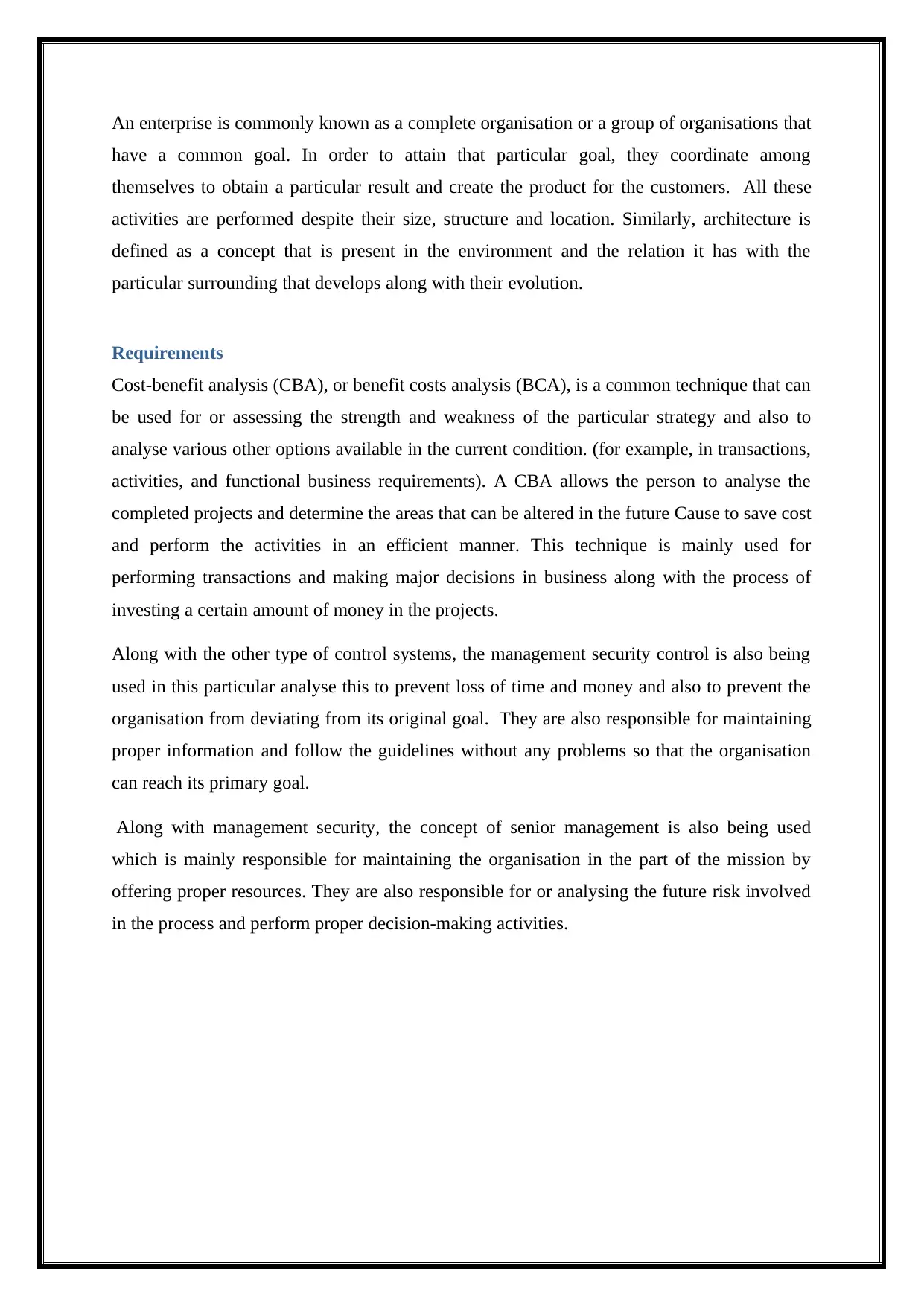
An enterprise is commonly known as a complete organisation or a group of organisations that
have a common goal. In order to attain that particular goal, they coordinate among
themselves to obtain a particular result and create the product for the customers. All these
activities are performed despite their size, structure and location. Similarly, architecture is
defined as a concept that is present in the environment and the relation it has with the
particular surrounding that develops along with their evolution.
Requirements
Cost-benefit analysis (CBA), or benefit costs analysis (BCA), is a common technique that can
be used for or assessing the strength and weakness of the particular strategy and also to
analyse various other options available in the current condition. (for example, in transactions,
activities, and functional business requirements). A CBA allows the person to analyse the
completed projects and determine the areas that can be altered in the future Cause to save cost
and perform the activities in an efficient manner. This technique is mainly used for
performing transactions and making major decisions in business along with the process of
investing a certain amount of money in the projects.
Along with the other type of control systems, the management security control is also being
used in this particular analyse this to prevent loss of time and money and also to prevent the
organisation from deviating from its original goal. They are also responsible for maintaining
proper information and follow the guidelines without any problems so that the organisation
can reach its primary goal.
Along with management security, the concept of senior management is also being used
which is mainly responsible for maintaining the organisation in the part of the mission by
offering proper resources. They are also responsible for or analysing the future risk involved
in the process and perform proper decision-making activities.
have a common goal. In order to attain that particular goal, they coordinate among
themselves to obtain a particular result and create the product for the customers. All these
activities are performed despite their size, structure and location. Similarly, architecture is
defined as a concept that is present in the environment and the relation it has with the
particular surrounding that develops along with their evolution.
Requirements
Cost-benefit analysis (CBA), or benefit costs analysis (BCA), is a common technique that can
be used for or assessing the strength and weakness of the particular strategy and also to
analyse various other options available in the current condition. (for example, in transactions,
activities, and functional business requirements). A CBA allows the person to analyse the
completed projects and determine the areas that can be altered in the future Cause to save cost
and perform the activities in an efficient manner. This technique is mainly used for
performing transactions and making major decisions in business along with the process of
investing a certain amount of money in the projects.
Along with the other type of control systems, the management security control is also being
used in this particular analyse this to prevent loss of time and money and also to prevent the
organisation from deviating from its original goal. They are also responsible for maintaining
proper information and follow the guidelines without any problems so that the organisation
can reach its primary goal.
Along with management security, the concept of senior management is also being used
which is mainly responsible for maintaining the organisation in the part of the mission by
offering proper resources. They are also responsible for or analysing the future risk involved
in the process and perform proper decision-making activities.
Paraphrase This Document
Need a fresh take? Get an instant paraphrase of this document with our AI Paraphraser
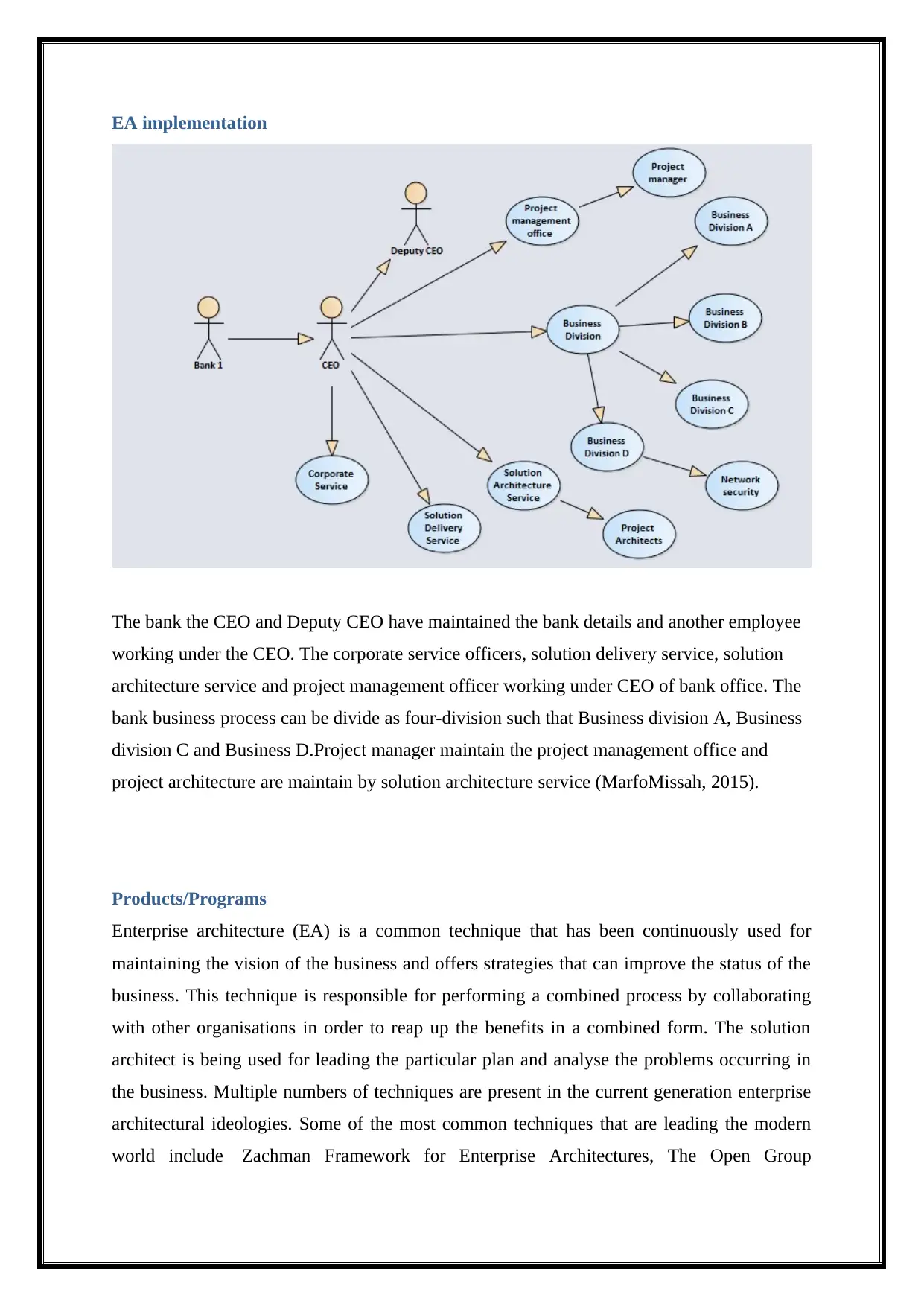
EA implementation
The bank the CEO and Deputy CEO have maintained the bank details and another employee
working under the CEO. The corporate service officers, solution delivery service, solution
architecture service and project management officer working under CEO of bank office. The
bank business process can be divide as four-division such that Business division A, Business
division C and Business D.Project manager maintain the project management office and
project architecture are maintain by solution architecture service (MarfoMissah, 2015).
Products/Programs
Enterprise architecture (EA) is a common technique that has been continuously used for
maintaining the vision of the business and offers strategies that can improve the status of the
business. This technique is responsible for performing a combined process by collaborating
with other organisations in order to reap up the benefits in a combined form. The solution
architect is being used for leading the particular plan and analyse the problems occurring in
the business. Multiple numbers of techniques are present in the current generation enterprise
architectural ideologies. Some of the most common techniques that are leading the modern
world include Zachman Framework for Enterprise Architectures, The Open Group
The bank the CEO and Deputy CEO have maintained the bank details and another employee
working under the CEO. The corporate service officers, solution delivery service, solution
architecture service and project management officer working under CEO of bank office. The
bank business process can be divide as four-division such that Business division A, Business
division C and Business D.Project manager maintain the project management office and
project architecture are maintain by solution architecture service (MarfoMissah, 2015).
Products/Programs
Enterprise architecture (EA) is a common technique that has been continuously used for
maintaining the vision of the business and offers strategies that can improve the status of the
business. This technique is responsible for performing a combined process by collaborating
with other organisations in order to reap up the benefits in a combined form. The solution
architect is being used for leading the particular plan and analyse the problems occurring in
the business. Multiple numbers of techniques are present in the current generation enterprise
architectural ideologies. Some of the most common techniques that are leading the modern
world include Zachman Framework for Enterprise Architectures, The Open Group
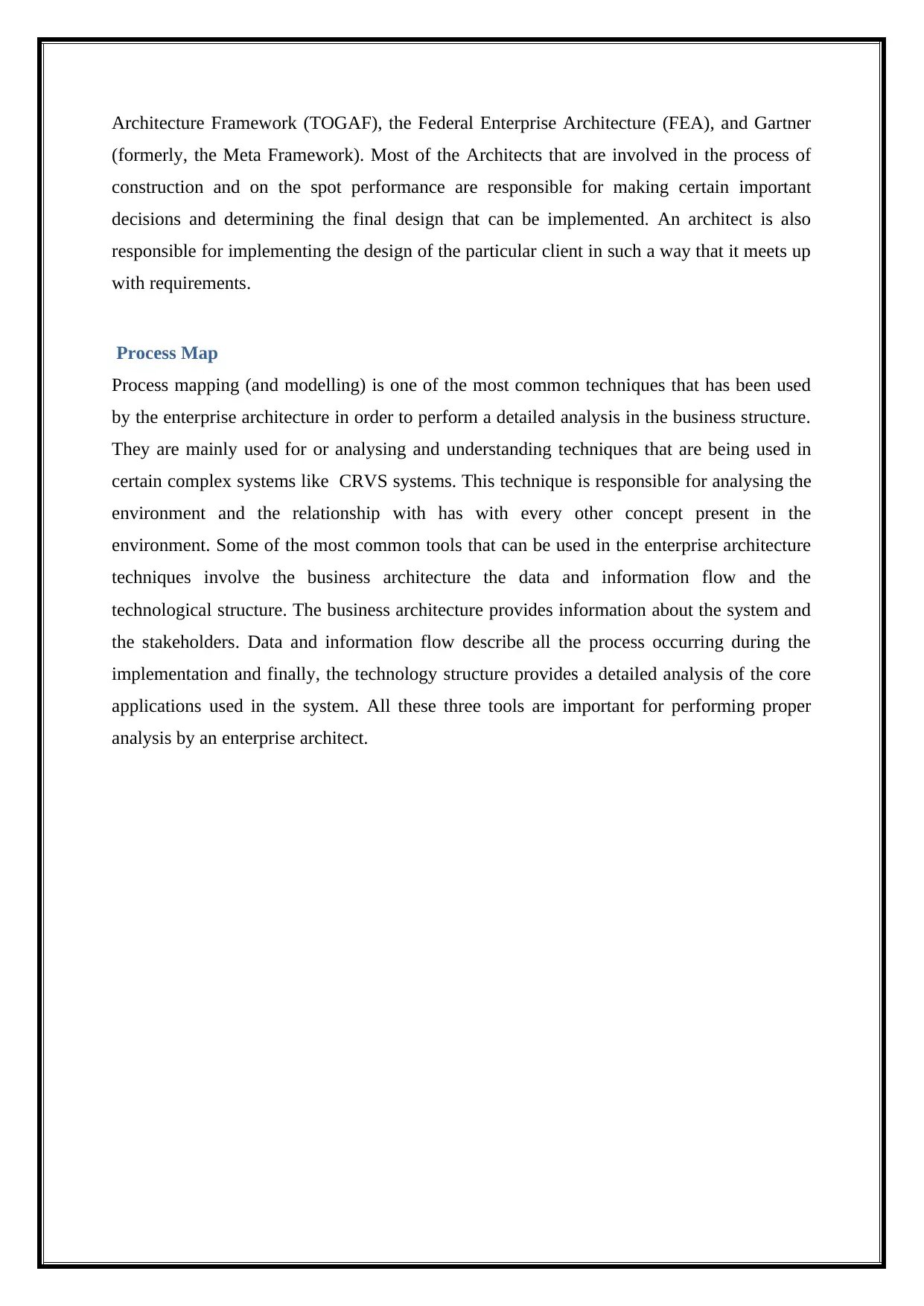
Architecture Framework (TOGAF), the Federal Enterprise Architecture (FEA), and Gartner
(formerly, the Meta Framework). Most of the Architects that are involved in the process of
construction and on the spot performance are responsible for making certain important
decisions and determining the final design that can be implemented. An architect is also
responsible for implementing the design of the particular client in such a way that it meets up
with requirements.
Process Map
Process mapping (and modelling) is one of the most common techniques that has been used
by the enterprise architecture in order to perform a detailed analysis in the business structure.
They are mainly used for or analysing and understanding techniques that are being used in
certain complex systems like CRVS systems. This technique is responsible for analysing the
environment and the relationship with has with every other concept present in the
environment. Some of the most common tools that can be used in the enterprise architecture
techniques involve the business architecture the data and information flow and the
technological structure. The business architecture provides information about the system and
the stakeholders. Data and information flow describe all the process occurring during the
implementation and finally, the technology structure provides a detailed analysis of the core
applications used in the system. All these three tools are important for performing proper
analysis by an enterprise architect.
(formerly, the Meta Framework). Most of the Architects that are involved in the process of
construction and on the spot performance are responsible for making certain important
decisions and determining the final design that can be implemented. An architect is also
responsible for implementing the design of the particular client in such a way that it meets up
with requirements.
Process Map
Process mapping (and modelling) is one of the most common techniques that has been used
by the enterprise architecture in order to perform a detailed analysis in the business structure.
They are mainly used for or analysing and understanding techniques that are being used in
certain complex systems like CRVS systems. This technique is responsible for analysing the
environment and the relationship with has with every other concept present in the
environment. Some of the most common tools that can be used in the enterprise architecture
techniques involve the business architecture the data and information flow and the
technological structure. The business architecture provides information about the system and
the stakeholders. Data and information flow describe all the process occurring during the
implementation and finally, the technology structure provides a detailed analysis of the core
applications used in the system. All these three tools are important for performing proper
analysis by an enterprise architect.
⊘ This is a preview!⊘
Do you want full access?
Subscribe today to unlock all pages.

Trusted by 1+ million students worldwide
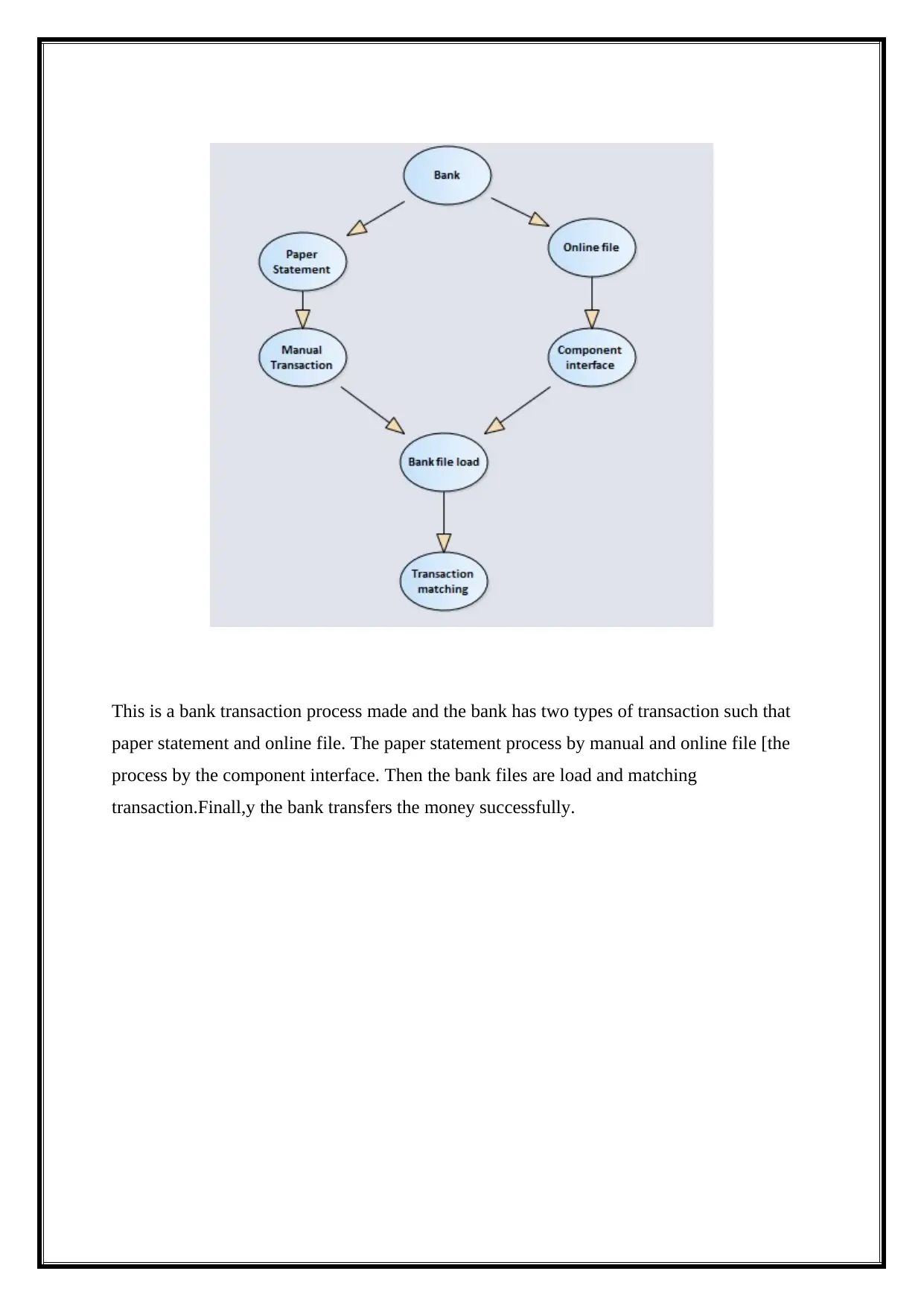
This is a bank transaction process made and the bank has two types of transaction such that
paper statement and online file. The paper statement process by manual and online file [the
process by the component interface. Then the bank files are load and matching
transaction.Finall,y the bank transfers the money successfully.
paper statement and online file. The paper statement process by manual and online file [the
process by the component interface. Then the bank files are load and matching
transaction.Finall,y the bank transfers the money successfully.
Paraphrase This Document
Need a fresh take? Get an instant paraphrase of this document with our AI Paraphraser
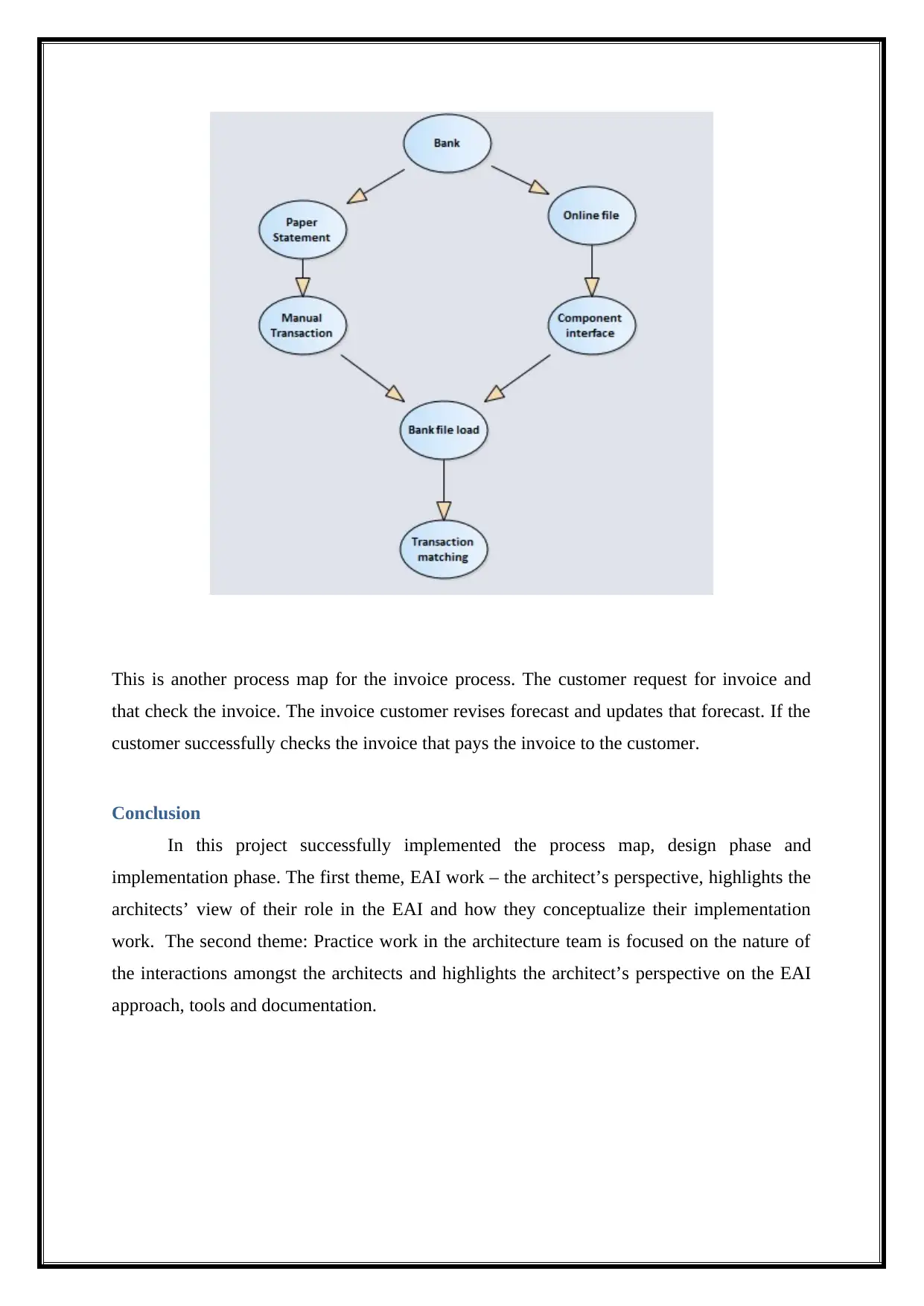
This is another process map for the invoice process. The customer request for invoice and
that check the invoice. The invoice customer revises forecast and updates that forecast. If the
customer successfully checks the invoice that pays the invoice to the customer.
Conclusion
In this project successfully implemented the process map, design phase and
implementation phase. The first theme, EAI work – the architect’s perspective, highlights the
architects’ view of their role in the EAI and how they conceptualize their implementation
work. The second theme: Practice work in the architecture team is focused on the nature of
the interactions amongst the architects and highlights the architect’s perspective on the EAI
approach, tools and documentation.
that check the invoice. The invoice customer revises forecast and updates that forecast. If the
customer successfully checks the invoice that pays the invoice to the customer.
Conclusion
In this project successfully implemented the process map, design phase and
implementation phase. The first theme, EAI work – the architect’s perspective, highlights the
architects’ view of their role in the EAI and how they conceptualize their implementation
work. The second theme: Practice work in the architecture team is focused on the nature of
the interactions amongst the architects and highlights the architect’s perspective on the EAI
approach, tools and documentation.
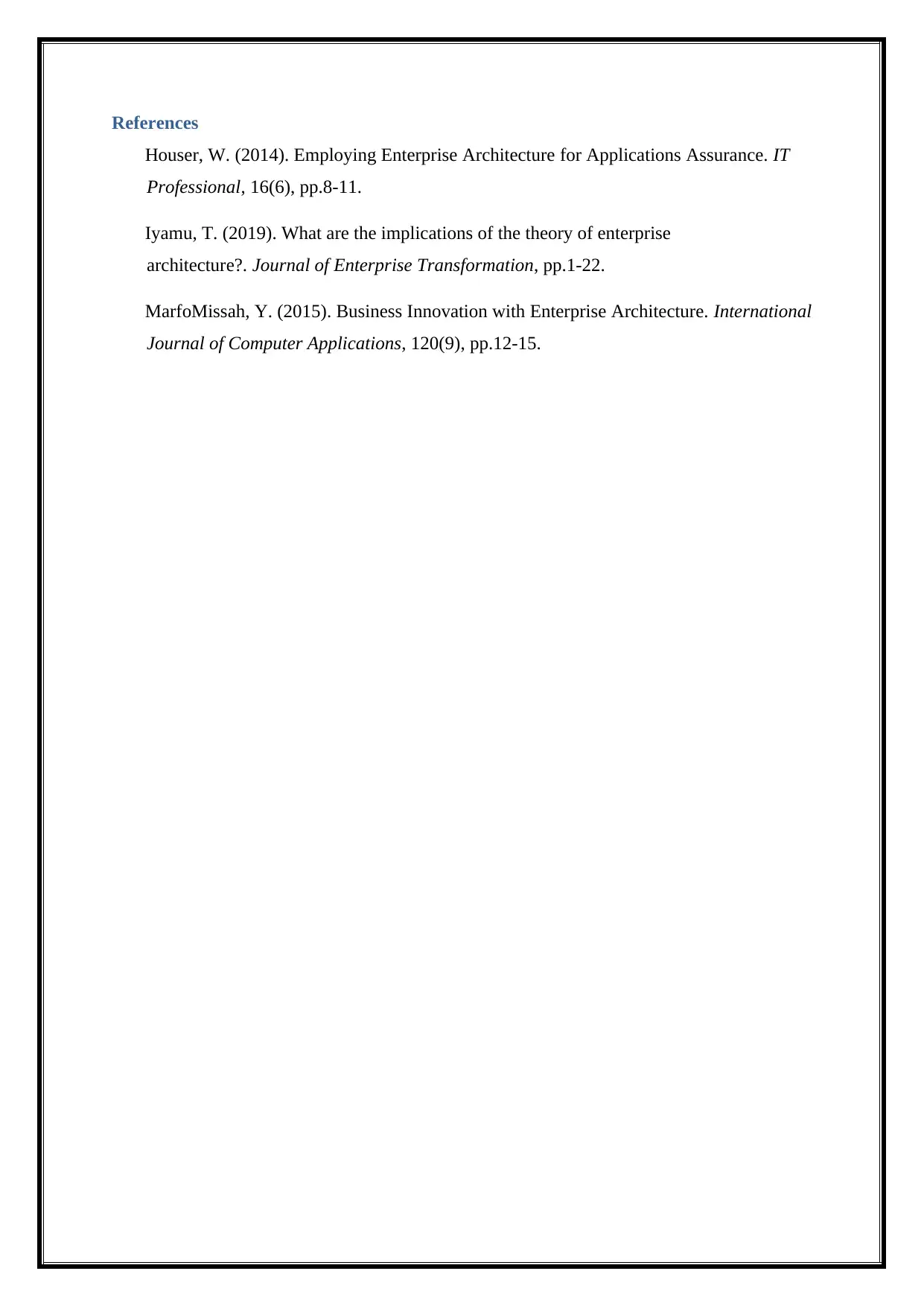
References
Houser, W. (2014). Employing Enterprise Architecture for Applications Assurance. IT
Professional, 16(6), pp.8-11.
Iyamu, T. (2019). What are the implications of the theory of enterprise
architecture?. Journal of Enterprise Transformation, pp.1-22.
MarfoMissah, Y. (2015). Business Innovation with Enterprise Architecture. International
Journal of Computer Applications, 120(9), pp.12-15.
Houser, W. (2014). Employing Enterprise Architecture for Applications Assurance. IT
Professional, 16(6), pp.8-11.
Iyamu, T. (2019). What are the implications of the theory of enterprise
architecture?. Journal of Enterprise Transformation, pp.1-22.
MarfoMissah, Y. (2015). Business Innovation with Enterprise Architecture. International
Journal of Computer Applications, 120(9), pp.12-15.
⊘ This is a preview!⊘
Do you want full access?
Subscribe today to unlock all pages.

Trusted by 1+ million students worldwide
1 out of 12
Your All-in-One AI-Powered Toolkit for Academic Success.
+13062052269
info@desklib.com
Available 24*7 on WhatsApp / Email
![[object Object]](/_next/static/media/star-bottom.7253800d.svg)
Unlock your academic potential
Copyright © 2020–2025 A2Z Services. All Rights Reserved. Developed and managed by ZUCOL.

